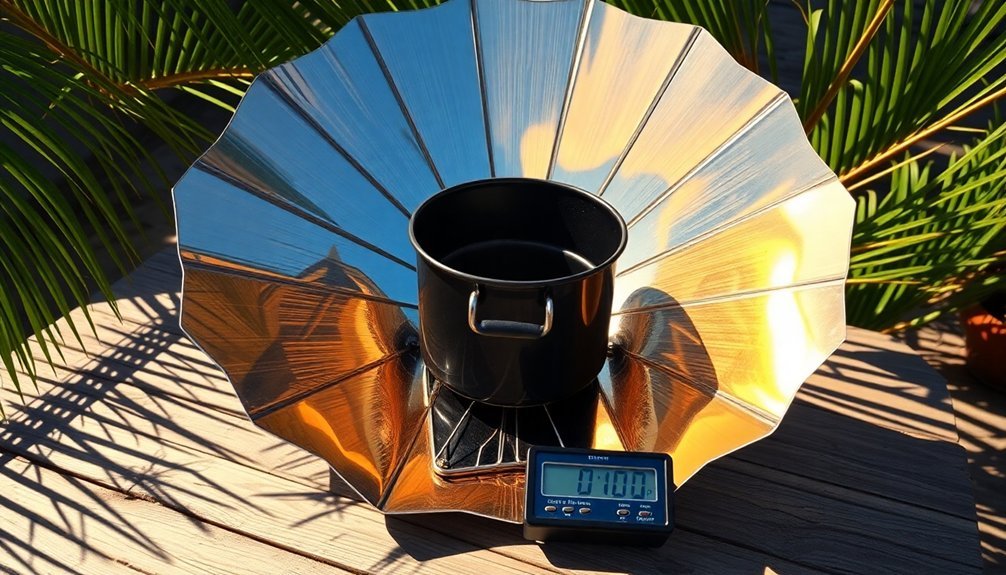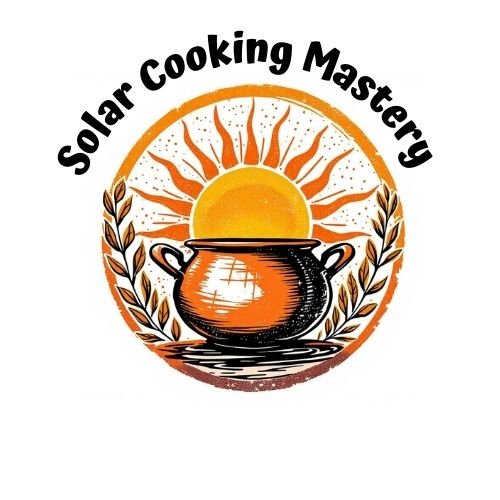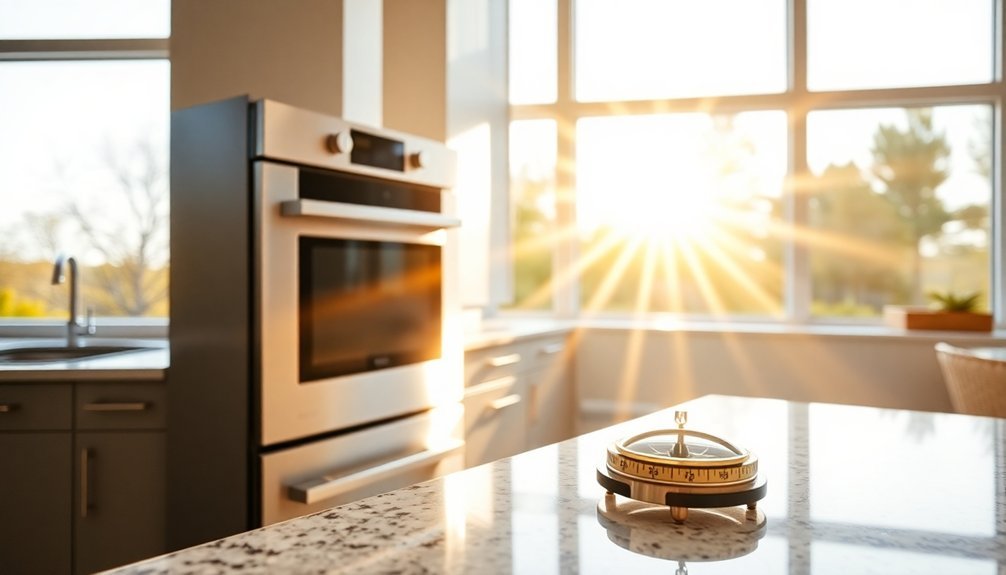To optimize your solar cooking setup, you'll need to adjust your cooking angles based on your specific climate zone. For equatorial regions, maintain a consistent east-west orientation with 45-degree angles, while desert areas require steeper angles between 30-60 degrees. If you're in the mountains, use paving stones for stability and double-layer insulation, adjusting angles every 30 minutes. Tropical zones work best at 45 degrees between 10 AM and 2 PM, while temperate regions need seasonal adjustments to maximize sunlight exposure. Each climate zone offers unique challenges and opportunities that can transform your solar cooking experience.
Equatorial Solar Cooking Basics

While many cooking methods require constant adjustments throughout the year, equatorial solar cooking offers unique advantages due to its location near Earth's center line.
You'll benefit from more direct sunlight and consistent cooking conditions throughout the year, making it easier to plan your daily meals.
Your solar box cooker won't need frequent repositioning, especially during midday hours when the sun's intensity is at its peak.
If you're at higher elevations, you'll get even better results from the unfiltered sunlight.
You can expect about 12 hours of daylight, with 6 solid hours of cooking time on most days.
To maximize efficiency, position your cooker with a longer east-west dimension, and you'll maintain steady temperatures without constant monitoring.
For optimal performance, you may need to reorient every 20-30 minutes when using parabolic-style cookers to maintain consistent heating.
Desert Heat Reflection Methods
Desert regions present unique opportunities for solar cooking, building on the principles that work well in equatorial zones.
To maximize your oven's performance, you'll need to focus on strategic reflection methods that capture the intense desert sun. Cover your oven's interior with aluminum foil tape, ensuring every surface reflects light toward your cooking vessel.
You'll want to use dark pots that absorb heat efficiently while positioning your oven between 10 AM and 4 PM for ideal exposure. Since desert weather can be unpredictable, it's smart to start cooking early to avoid afternoon clouds, especially during monsoon season. Experienced solar chefs know that high thin clouds can dramatically reduce cooking efficiency.
Keep adjusting your oven's angle throughout the day to track the sun's movement. When clouds threaten your cooking time, have a hay box cooker ready to maintain food temperature and complete the cooking process.
Tropical Zone Cooking Positions

Since tropical zones experience consistent sunlight throughout the year, you'll need to adapt your cooking positions to handle the region's high humidity and frequent cloud cover. Position your camera at a 45-degree angle when photographing soups and one-pot meals, using a 100mm lens to capture the dish's surface detail through the humid air. Using a reliable tripod setup will give you the stability needed in tropical conditions.
| Angle Type | Best For | Key Benefit |
|---|---|---|
| Overhead | Salads & Platters | Pattern Enhancement |
| Straight-On | Sandwiches & Burgers | Layer Visibility |
| Lower Angle | Shallow Plates | Texture Display |
For layered dishes like tropical fruit parfaits, opt for straight-on shots to showcase each ingredient clearly. When capturing dishes with vibrant local ingredients, use overhead shots to emphasize the natural colors and shapes. Lower angle shots work particularly well for highlighting the thickness of grilled fish and meat dishes common in tropical cuisine.
Seasonal Angle Adjustments
As the seasons change throughout the year, you'll need to adjust your food photography angles to complement the unique characteristics of seasonal ingredients.
In spring, shoot light dishes like tender greens and chilled salads from higher angles to capture their fresh, delicate nature.
Position your camera at 45 degrees for summer's colorful berries and chilled grain bowls, highlighting their vibrant layers and textures.
For fall's heartier fare, lower your shooting angle to 30-35 degrees to emphasize the depth of slow-cooked stews and root vegetables.
This perspective adds drama to steam rising from warm dishes and captures the rich textures of seasonal squashes and baked fruits.
Remember to adjust your lighting alongside your angles to match each season's natural ambiance and food preparation methods.
Mountain Region Solar Setup

While mountain regions present unique challenges for solar cooking, setting up your equipment properly will guarantee excellent results. You'll need to carefully select a location that maximizes sun exposure while considering the local terrain. Choose a sturdy, level surface that's accessible yet safe from foot traffic.
| Setup Element | Mountain Challenge | Solution |
|---|---|---|
| Location | Variable terrain | Use paving stones for stability |
| Sunlight | Topographical shadows | Position away from obstructions |
| Angle | Elevation factors | Adjust 30-60° based on season |
| Insulation | Temperature fluctuation | Double-layer with thermal mass |
| Monitoring | Weather changes | Check every 30 minutes |
For peak performance, use black cookware and create a well-insulated environment. You'll want to preheat for 30 minutes and maintain proper alignment with the sun throughout cooking time. Don't forget to add reflective surfaces to boost heat collection and retention.
Polar Zone Cooking Strategies
When cooking in polar zones, you'll want to position your stove's steam vent away from your line of sight to prevent frost buildup on your protective eyewear and face covering.
Your MSR XGK EX stove should be angled slightly forward on your insulated mounting board to help control steam flow and maintain ideal fuel pressure in extreme cold.
Establish your cooking station with clear sightlines by using a paneled windshield that blocks wind while allowing you to monitor your stove's performance without exposing yourself to harsh conditions.
Steam Control Positioning
Living in polar regions requires mastering steam control techniques for successful cooking outcomes. You'll need to position your cooking vessels strategically to manage moisture in the dry environment. Use insulated containers with tight-fitting lids to trap precious steam and maximize heat retention.
| Position | Purpose | Best For |
|---|---|---|
| Vertical | Maximum steam retention | Stews & soups |
| Angled | Controlled condensation | Seafood & seal |
| Horizontal | Minimal moisture loss | Bread & pemmican |
When cooking, you'll want to maintain steady temperatures using thermal cookers or portable stoves. Position your cooking vessel to minimize heat loss while allowing just enough steam release to achieve your desired consistency. Remember to test your setup before heading into the field, as proper steam control can mean the difference between a successful meal and wasted resources.
Frost-Free Cooking Views
Clear visibility during food preparation adds another layer to successful polar cooking. When you're working with energy-dense ingredients like pemmican and seal meat, you'll want to position your cooking station where frost won't obstruct your view. This is especially important when you're preparing traditional hoosh or adapting recipes for extreme conditions.
Set up your workspace to take advantage of natural light while staying protected from direct wind. You'll need clear sightlines to monitor food consistency, particularly when you're blanching meat or preparing expedition-style bread.
If you're working with preserved foods like sledging biscuits or vacuum-sealed items, arrange them where temperature fluctuations won't cause condensation on your preparation surface. Keep your ingredients visible and within reach to maintain efficiency during cooking sessions.
Coastal Weather Considerations

Along coastal regions, your cooking methods must adapt to unique environmental challenges, including salt-laden air and high humidity.
You'll find that traditional coastal communities have developed smart techniques that work with, rather than against, these conditions. Grilling and steaming help preserve delicate seafood flavors while accommodating the humid environment.
- Use tidal zones to your advantage by harvesting fresh seafood during ideal cycles
- Adapt your preservation methods to account for salt-rich air when curing fish
- Choose simple, hearty combinations like baked flounder with potatoes when fresh herbs aren't available
- Consider sustainable practices like oyster tables for reliable seafood sourcing
- Embrace flexible cooking schedules that respond to changing seasonal patterns
These adaptations will help you master coastal cooking while working harmoniously with your environment's unique characteristics.
Rainforest Solar Cooking Tips
Position your solar cooker to catch maximum sunlight between 10 AM and 2 PM, when the sun's intensity is highest in rainforest regions and your shadow is shortest.
You'll need to protect your cooking equipment with a simple waterproof cover during unexpected rain showers, which are common in tropical climates.
During the wet season, you can improve your success rate by pre-soaking ingredients and planning quick-cooking meals that work well even with intermittent sunshine.
Optimal Sun Position Placement
While rainforest environments present unique challenges for solar cooking, understanding ideal sun positioning can help you maximize your cooking success.
You'll want to place your cooker between 11:00 am and 3:00 pm when sunlight breaks through the canopy most effectively. Adjust your cooker's orientation based on meal timing – easterly for noon meals and westerly for evening dishes.
- Start cooking by 9:00 am for lunch preparations
- Orient your cooker's shorter panel toward the sun's path
- Check that the cooker's shadow falls directly behind it
- Tilt the device to compensate for filtered sunlight through trees
- Monitor weather patterns and plan meals during clearest periods
In rainforest zones, you'll need to be extra vigilant about adjusting your cooker's position as the sun moves through gaps in the canopy.
Equipment Weather Protection Tips
Protecting your solar cooking equipment becomes essential in rainforest environments where high humidity and frequent rainfall can damage components.
You'll need to select cookers made from weather-resistant materials and apply waterproof coatings to guard against moisture damage.
Store your cooker in a dry place when it's not in use, and always use protective covers or waterproof bags during storage.
You'll want to check it regularly for signs of rust or corrosion, especially after rainy periods.
Don't forget to clean it thoroughly after each use to prevent moisture-related deterioration.
During operation, elevate your cooker to improve airflow and reduce water accumulation.
Make sure you're using corrosion-resistant pots and pans, and secure the setup with weights or anchors to handle unexpected gusts of wind.
Seasonal Timing Adjustments
Beyond safeguarding your equipment, mastering the timing of solar cooking in rainforest environments will maximize your success rate.
You'll need to adapt your cooking schedule to account for frequent cloud cover and seasonal variations in sun position. Start cooking earlier in the day, ideally by 10:00 am, to take advantage of peak sunlight hours between 11:00 am and 3:00 pm.
- Pre-soak beans and grains the night before to reduce cooking time during limited sun exposure
- Move your cooker every couple of hours to track the sun's position
- Plan quick-cooking meals for days with intermittent clouds
- Choose cooking locations away from tall trees that cast shadows
- Check weather forecasts to schedule long-cooking dishes on the sunniest days
Mediterranean Climate Cooking Angles

Since Mediterranean climates feature hot, dry summers and mild winters, your cooking approach should adapt to these distinct seasonal changes.
During summer months, you'll want to focus on quick-cooking methods like grilling vegetables and fish, which help keep your kitchen cool while adding smoky flavors. Fresh herbs, citrus, and olive oil become your go-to ingredients for light, invigorating dishes.
As temperatures drop in winter, shift to slow-cooking techniques that develop rich flavors in hearty stews and braises. You'll find that marinating becomes especially effective in cooler weather, when meats can safely rest longer.
Adapt your produce choices to match the seasons – emphasizing tomatoes and cucumbers in summer, shifting to root vegetables and legumes in winter. Remember to char vegetables year-round for that authentic Mediterranean smokiness.
Arid Region Setup Guide
When setting up your cooking space in an arid region, you'll need to adapt to both intense sun exposure and dry conditions. Your location's latitude will determine the ideal angle for solar cooking, while traditional methods can complement your setup during less sunny periods.
Combine solar cooking with time-tested arid land techniques to maximize your cooking options.
- Position your solar cooker at a steeper angle during winter months to capture more direct sunlight
- Set up a dedicated pit cooking area for slow-cooking tough meats and retaining moisture
- Install your cooking station at a higher elevation when possible for more intense solar energy
- Keep portable stoves as backup for cloudy days or evening meals
- Create a moisture-retention system using clay pots and underground cooking methods
Temperate Zone Position Planning

When setting up your cooking space in a temperate zone, you'll need to account for the dramatic seasonal shifts in sunlight patterns and glare throughout the year.
Your workspace positioning should maximize natural light during darker winter months while maintaining adequate shade options for bright summer days.
Consider placing your main prep area where you can easily adjust between direct and indirect lighting as the seasons change, keeping in mind how sunlight moves across your space during peak cooking hours.
Sunlight Direction and Shade
Getting the most from your solar cooker in temperate zones depends heavily on understanding sunlight patterns and shade management.
You'll need to position your cooker where the sun's angle reaches at least 45 degrees, typically between 10 AM and 2 PM for ideal temperatures. Check that objects cast shadows shorter than their height to confirm sufficient sun elevation.
- Track the sun's path to avoid building and tree shadows
- Position your cooker facing the sun's midday location
- Adjust reflectors every 1-2 hours for maximum sunlight capture
- Monitor internal temperature with an oven thermometer
- Clear away any movable objects that might cast shadows
Remember to take into account seasonal changes in sun angles when selecting your cooking spot.
In temperate zones, you'll find the best cooking results during the four to six months with highest sun elevation.
Seasonal Glare Management
Managing seasonal glare effectively complements your solar cooking setup and guarantees consistent performance throughout the year. You'll need to adapt your setup using both automated and manual solutions to handle changing sun angles and intensities across seasons.
| Season | Morning Position | Afternoon Position |
|---|---|---|
| Summer | Use motorized shades with smart sensors | Deploy overhangs or louvers |
| Spring/Fall | Adjust vertical blinds 45° | Position light shelves horizontally |
| Winter | Minimize shading, maximize exposure | Use reflective systems for boost |
Consider installing automated shading systems that'll adjust based on the sun's position. These can work alongside your manual controls, giving you ideal cooking conditions. For best results, integrate vegetation strategically around your cooking area – deciduous trees provide summer shade while allowing winter sun through. You'll also want to incorporate adjustable reflecting systems to redirect sunlight when needed.
Ambient Light Positioning
Proper ambient light positioning in temperate zones requires a strategic balance between natural and artificial illumination throughout your kitchen space.
You'll want to maximize natural light by positioning your workspaces near windows while ensuring uniform artificial lighting for cloudy days and evening hours.
Combine overhead fixtures with under-cabinet lighting to eliminate shadows and create consistent illumination across all surfaces.
- Position central pendant lights at ideal heights to provide even coverage without creating glare
- Install task lighting at 45-degree angles above primary work areas
- Layer your lighting with a mix of warm (2700K-3000K) and cool (3500K-4000K) temperatures
- Use adjustable fixtures to adapt to changing seasonal daylight patterns
- Place ambient light sources strategically to complement your kitchen's natural orientation, whether north or south-facing
Frequently Asked Questions
Can Solar Cooking Angles Affect Food Photography Composition in Different Climate Zones?
You'll find that solar cooking angles don't directly impact your food photography composition, but they can affect lighting conditions and shadows. You'll need to adjust your camera angles based on available natural light.
How Do Traditional Cooking Angles Compare With Modern Solar Cooking Positions?
You'll find traditional cooking rarely needs specific angles, while modern solar cooking requires precise positioning. You must constantly adjust solar cookers to follow the sun, unlike traditional methods that are more flexible.
What Safety Precautions Should Be Taken When Adjusting Cooking Angles Mid-Recipe?
When adjusting cooking angles, you'll need to use heat-resistant gloves, avoid steam burns, guarantee stable equipment positioning, and always check food temperatures after repositioning. Don't forget to maintain proper ventilation throughout the process.
Do Cooking Angle Requirements Change During Extreme Weather Events?
You'll need to adjust your cooking angles during extreme weather, especially in high winds. Keep your cooker more level and stable, and avoid steep angles that could make your equipment unstable or dangerous.
Which Materials Work Best for Angle-Adjustable Cooking Platforms in Various Climates?
You'll want stainless steel 304 for humid zones, copper-core materials for cold climates, reinforced aluminum for high altitudes, and marine-grade steel 316 for coastal areas. All should have corrosion-resistant adjustable mechanisms.
In Summary
You'll find solar cooking success comes down to understanding your specific climate zone and adjusting accordingly. Whether you're in the tropics or temperate regions, the right angle makes all the difference. Remember to track seasonal changes and adapt your setup throughout the year. With these zone-specific techniques, you've got the knowledge to harness the sun's power effectively, no matter where you live.





Leave a Reply